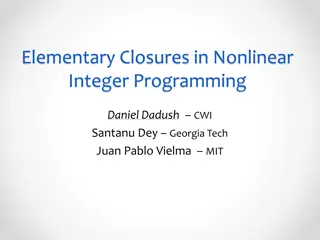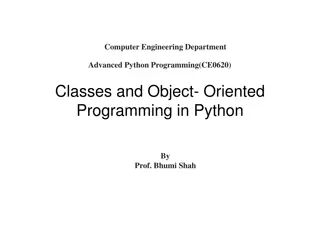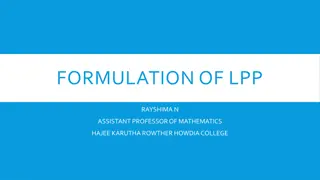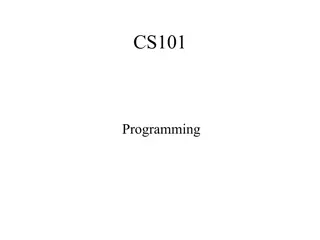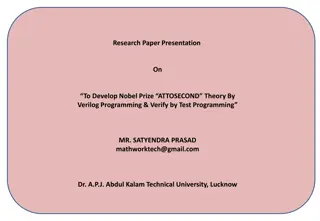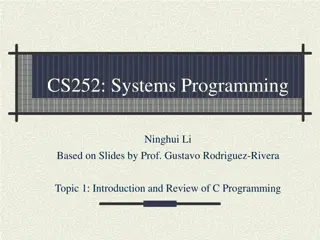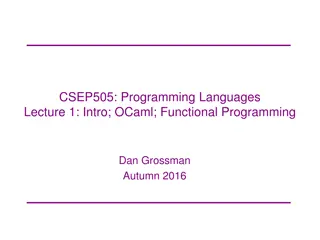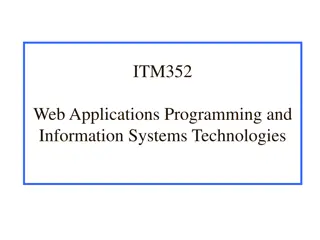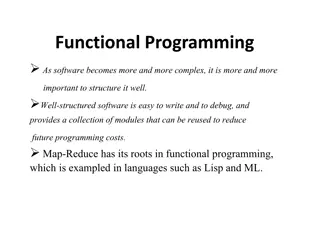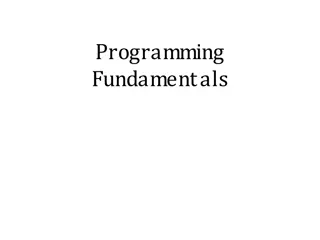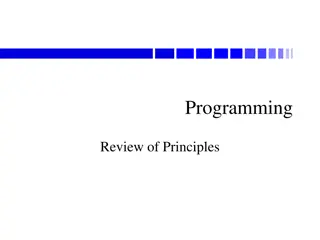Programming
The evolution of the OpenGL pipeline, from fixed-function operations to programmable shaders. Learn about the latest versions of OpenGL, including GLSL shaders and the efficient use of GPU resources. Dive into the basics of OpenGL rendering and its role in creating high-quality color images for interactive 3D graphics applications.
Download Presentation

Please find below an Image/Link to download the presentation.
The content on the website is provided AS IS for your information and personal use only. It may not be sold, licensed, or shared on other websites without obtaining consent from the author.If you encounter any issues during the download, it is possible that the publisher has removed the file from their server.
You are allowed to download the files provided on this website for personal or commercial use, subject to the condition that they are used lawfully. All files are the property of their respective owners.
The content on the website is provided AS IS for your information and personal use only. It may not be sold, licensed, or shared on other websites without obtaining consent from the author.
E N D
Presentation Transcript
Introduction to Modern OpenGL Programming Ed Angel University of New Mexico Dave Shreiner ARM, Inc
Agenda Evolution of the OpenGL Pipeline A Prototype Application in OpenGL OpenGL Shading Language (GLSL) Vertex Shaders Fragment Shaders Examples
What Is OpenGL? OpenGL is a computer graphics rendering API With it, you can generate high-quality color images by rendering with geometric and image primitives It forms the basis of many interactive applications that include 3D graphics By using OpenGL, the graphics part of your application can be operating system independent window system independent
Course Ground Rules We ll concentrate on the latest versions of OpenGL They enforce a new way to program with OpenGL Allows more efficient use of GPU resources If you re familiar with classic graphics pipelines, modern OpenGL doesn t support Fixed-function graphics operations lighting transformations All applications must use shaders for their graphics processing
The Evolution of the OpenGL Pipeline
In the Beginning OpenGL 1.0 was released on July 1st, 1994 Its pipeline was entirely fixed-function the only operations available were fixed by the implementation Vertex Transform and Lighting Vertex Data Primitive Setup and Rasterization Fragment Coloring and Texturing Blending Pixel Data Texture Store The pipeline evolved, but remained fixed-function through OpenGL versions 1.1 through 2.0 (Sept. 2004)
The Start of the Programmable Pipeline OpenGL 2.0 (officially) added programmable shaders vertex shading augmented the fixed-function transform and lighting stage fragment shading augmented the fragment coloring stage However, the fixed-function pipeline was still available Vertex Transform and Lighting Vertex Data Primitive Setup and Rasterization Fragment Coloring and Texturing Blending Pixel Data Texture Store
An Evolutionary Change OpenGL 3.0 introduced the deprecation model the method used to remove features from OpenGL The pipeline remained the same until OpenGL 3.1 (released March 24th, 2009) Introduced a change in how OpenGL contexts are used Context Type Description Includes all features (including those marked deprecated) available in the current version of OpenGL Full Includes all non-deprecated features (i.e., creates a context that would be similar to the next version of OpenGL) Forward Compatible
The Exclusively Programmable Pipeline OpenGL 3.1 removed the fixed-function pipeline programs were required to use only shaders Vertex Data Vertex Shader Primitive Setup and Rasterization Fragment Shader Blending Texture Store Pixel Data Additionally, almost all data is GPU-resident all vertex data sent using buffer objects
More Programability OpenGL 3.2 (released August 3rd, 2009) added an additional shading stage geometry shaders Vertex Data Vertex Shader Primitive Setup and Rasterization Fragment Shader Blending Geometry Shader Texture Store Pixel Data
More Evolution Context Profiles OpenGL 3.2 also introduced context profiles profiles control which features are exposed it s like GL_ARB_compatibility, only not insane currently two types of profiles: core and compatible Context Type Profile Description core All features of the current release Full compatible All features ever in OpenGL core All non-deprecated features Forward Compatible compatible Not supported
The Latest Pipelines OpenGL 4.1 (released July 25th, 2010) included additional shading stages tessellation-control and tessellation-evaluation shaders Latest version is 4.3 Vertex Data Vertex Shader Primitive Setup and Rasterization Fragment Shader Blending Tessellation Evaluation Shader Tessellation Control Shader Geometry Shader Texture Store Pixel Data
OpenGL ES and WebGL OpenGL ES 2.0 Designed for embedded and hand-held devices such as cell phones Based on OpenGL 3.1 Shader based WebGL JavaScript implementation of ES 2.0 Runs on most recent browsers
OpenGL Application Development
A Simplified Pipeline Model Application Framebuffer GPU Data Flow Vertices Pixels Vertices Fragments Vertex Processing Fragment Processing Rasterizer Vertex Shader Fragment Shader
OpenGL Programming in a Nutshell Modern OpenGL programs essentially do the following steps: 1. Create shader programs 2. Create buffer objects and load data into them 3. Connect data locations with shader variables 4. Render
Application Framework Requirements OpenGL applications need a place to render into usually an on-screen window Need to communicate with native windowing system Each windowing system interface is different We use GLUT (more specifically, freeglut) simple, open-source library that works everywhere handles all windowing operations: opening windows input processing
Simplifying Working with OpenGL Operating systems deal with library functions differently compiler linkage and runtime libraries may expose different functions Additionally, OpenGL has many versions and profiles which expose different sets of functions managing function access is cumbersome, and window-system dependent We use another open-source library, GLEW, to hide those details
Representing Geometric Objects Geometric objects are represented using vertices A vertex is a collection of generic attributes x y z w positional coordinates colors texture coordinates any other data associated with that point in space Position stored in 4 dimensional homogeneous coordinates Vertex data must be stored in vertex buffer objects (VBOs) VBOs must be stored in vertex array objects (VAOs)
OpenGLs Geometric Primitives All primitives are specified by vertices GL_LINES GL_POINTS GL_LINE_STRIP GL_LINE_LOOP GL_TRIANGLES GL_TRIANGLE_FAN GL_TRIANGLE_STRIP
Our First Program We ll render a cube with colors at each vertex Our example demonstrates: initializing vertex data organizing data for rendering simple object modeling building up 3D objects from geometric primitives building geometric primitives from vertices
Initializing the Cubes Data We ll build each cube face from individual triangles Need to determine how much storage is required (6 faces)(2 triangles/face)(3 vertices/triangle) const int NumVertices = 36; To simplify communicating with GLSL, we ll use a vec4 class (implemented in C++) similar to GLSL s vec4 type we ll also typedef it to add logical meaning typedef vec4 point4; typedef vec4 color4;
Initializing the Cubes Data (contd) Before we can initialize our VBO, we need to stage the data Our cube has two attributes per vertex position color We create two arrays to hold the VBO data point4 points[NumVertices]; color4 colors[NumVertices];
Cube Data // Vertices of a unit cube centered at origin, sides aligned with axes point4 vertex_positions[8] = { point4( -0.5, -0.5, 0.5, 1.0 ), point4( -0.5, 0.5, 0.5, 1.0 ), point4( 0.5, 0.5, 0.5, 1.0 ), point4( 0.5, -0.5, 0.5, 1.0 ), point4( -0.5, -0.5, -0.5, 1.0 ), point4( -0.5, 0.5, -0.5, 1.0 ), point4( 0.5, 0.5, -0.5, 1.0 ), point4( 0.5, -0.5, -0.5, 1.0 ) };
Cube Data // RGBA colors color4 vertex_colors[8] = { color4( 0.0, 0.0, 0.0, 1.0 ), // black color4( 1.0, 0.0, 0.0, 1.0 ), // red color4( 1.0, 1.0, 0.0, 1.0 ), // yellow color4( 0.0, 1.0, 0.0, 1.0 ), // green color4( 0.0, 0.0, 1.0, 1.0 ), // blue color4( 1.0, 0.0, 1.0, 1.0 ), // magenta color4( 1.0, 1.0, 1.0, 1.0 ), // white color4( 0.0, 1.0, 1.0, 1.0 ) // cyan };
Generating a Cube Face from Vertices // quad() generates two triangles for each face and assigns colors to the vertices int Index = 0; // global variable indexing into VBO arrays void quad( int a, int b, int c, int d ) { colors[Index] = vertex_colors[a]; points[Index] = vertex_positions[a]; Index++; colors[Index] = vertex_colors[b]; points[Index] = vertex_positions[b]; Index++; colors[Index] = vertex_colors[c]; points[Index] = vertex_positions[c]; Index++; colors[Index] = vertex_colors[a]; points[Index] = vertex_positions[a]; Index++; colors[Index] = vertex_colors[c]; points[Index] = vertex_positions[c]; Index++; colors[Index] = vertex_colors[d]; points[Index] = vertex_positions[d]; Index++; }
Generating the Cube from Faces // generate 12 triangles: 36 vertices and 36 colors void colorcube() { quad( 1, 0, 3, 2 ); quad( 2, 3, 7, 6 ); quad( 3, 0, 4, 7 ); quad( 6, 5, 1, 2 ); quad( 4, 5, 6, 7 ); quad( 5, 4, 0, 1 ); }
Vertex Array Objects (VAOs) VAOs store the data of an geometric object Steps in using a VAO 1. generate VAO names by calling glGenVertexArrays() 2. bind a specific VAO for initialization by calling glBindVertexArray() 3. update VBOs associated with this VAO 4. bind VAO for use in rendering This approach allows a single function call to specify all the data for an objects previously, you might have needed to make many calls to make all the data current
VAOs in Code // Create a vertex array object GLuint vao; glGenVertexArrays( 1, &vao ); glBindVertexArray( vao );
Storing Vertex Attributes Vertex data must be stored in a VBO, and associated with a VAO The code-flow is similar to configuring a VAO 1. generate VBO names by calling glGenBuffers() 2. bind a specific VBO for initialization by calling glBindBuffer( GL_ARRAY_BUFFER, ) 3. load data into VBO using glBufferData( GL_ARRAY_BUFFER, ) 4. bind VAO for use in rendering glBindVertexArray()
VBOs in Code // Create and initialize a buffer object GLuint buffer; glGenBuffers( 1, &buffer ); glBindBuffer( GL_ARRAY_BUFFER, buffer ); glBufferData( GL_ARRAY_BUFFER, sizeof(points) + sizeof(colors), NULL, GL_STATIC_DRAW ); glBufferSubData( GL_ARRAY_BUFFER, 0, sizeof(points), points ); glBufferSubData( GL_ARRAY_BUFFER, sizeof(points), sizeof(colors), colors );
Connecting Vertex Shaders with Geometric Data Application vertex data enters the OpenGL pipeline through the vertex shader Need to connect vertex data to shader variables requires knowing the attribute location Attribute location can either be queried by calling glGetVertexAttribLocation()
Vertex Array Code // set up vertex arrays (after shaders are loaded) GLuint vPosition = glGetAttribLocation( program, "vPosition" ); glEnableVertexAttribArray( vPosition ); glVertexAttribPointer( vPosition, 4, GL_FLOAT, GL_FALSE, 0, BUFFER_OFFSET(0) ); GLuint vColor = glGetAttribLocation( program, "vColor" ); glEnableVertexAttribArray( vColor ); glVertexAttribPointer( vColor, 4, GL_FLOAT, GL_FALSE, 0, BUFFER_OFFSET(sizeof(points)) );
Drawing Geometric Primitives For contiguous groups of vertices glDrawArrays( GL_TRIANGLES, 0, NumVertices ); Usually invoked in display callback Initiates vertex shader
GLSL Data Types Scalar types: float, int, bool Vector types: vec2, vec3, vec4 ivec2, ivec3, ivec4 bvec2, bvec3, bvec4 Matrix types: mat2, mat3, mat4 Texture sampling: sampler1D, sampler2D, sampler3D, samplerCube C++ Style Constructors vec3 a = vec3(1.0, 2.0, 3.0);
Operators Standard C/C++ arithmetic and logic operators Operators overloaded for matrix and vector operations mat4 m; vec4 a, b, c; b = a*m; c = m*a;
Components and Swizzling For vectors can use [ ], xyzw, rgba or stpq Example: vec3 v; v[1], v.y, v.g, v.t all refer to the same element Swizzling: vec3 a, b; a.xy = b.yx;
Qualifiers in, out Copy vertex attributes and other variable to/ from shaders in vec2 tex_coord; out vec4 color; Uniform: variable from application uniform float time; uniform vec4 rotation;
Flow Control if if else expression ? true-expression : false- expression while, do while for
Functions Built in Arithmetic: sqrt, power, abs Trigonometric: sin, asin Graphical: length, reflect User defined
Built-in Variables gl_Position: output position from vertex shader gl_FragColor: output color from fragment shader Only for ES, WebGL and older versions of GLSL Present version use an out variable
Simple Vertex Shader for Cube Example in vec4 vPosition; in vec4 vColor; out vec4 color; void main() { color = vColor; gl_Position = vPosition; }
The Simplest Fragment Shader in vec4 color; out vec4 FragColor; void main() { FragColor = color; }
Getting Your Shaders into OpenGL Create Program glCreateProgram() Shaders need to be compiled and linked to form an executable shader program Create Shader glCreateShader() These steps need to be repeated for each type of shader in the shader program Load Shader Source glShaderSource() OpenGL provides the compiler and linker Compile Shader glCompileShader() A program must contain Attach Shader to Program glAttachShader() vertex and fragment shaders Link Program glLinkProgram() other shaders are optional Use Program glUseProgram()
A Simpler Way We ve created a routine for this course to make it easier to load your shaders available at course website GLuint InitShaders( const char* vFile, const char* fFile); InitShaderstakes two filenames vFile for the vertex shader fFile for the fragment shader Fails if shaders don t compile, or program doesn t link
Associating Shader Variables and Data Need to associate a shader variable with an OpenGL data source vertex shader attributes app vertex attributes shader uniforms app provided uniform values OpenGL relates shader variables to indices for the app to set Two methods for determining variable/index association specify association before program linkage query association after program linkage
Determining Locations After Linking Assumes you already know the variables name GLint idx = glGetAttribLocation( program, name ); GLint idx = glGetUniformLocation( program, name );
Initializing Uniform Variable Values Uniform Variables glUniform4f( index, x, y, z, w ); GLboolean transpose = GL_TRUE; // Since we re C programmers GLfloat mat[3][4][4] = { }; glUniformMatrix4fv( index, 3, transpose, mat );














